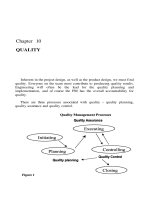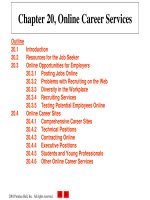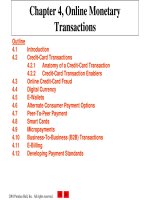Lecture E-commerce and e-business for managers - Chapter 10: E-customer relationship management
Bạn đang xem bản rút gọn của tài liệu. Xem và tải ngay bản đầy đủ của tài liệu tại đây (948.71 KB, 35 trang )
Chapter 10, eCustomer Relationship
Management
Outline
10.1
Introduction
10.2
10.3
10.4
10.5
10.6
Tracking and Analyzing Data
10.2.1 LogFile Analysis
10.2.2 Data Mining
10.2.3 Customer Registration
10.2.4 Cookies
Personalization
10.3.1 Intelligent Agents
10.3.2 Personalization vs. Privacy
Contact Centers
10.4.1 Frequently Asked Questions (FAQs)
10.4.2 eMail
10.4.3 Online Text Chatting
10.4.4 Speech Synthesis and Recognition; Natural Language Processing
10.4.5 Voice Communications
10.4.6 SalesForce Automation
BusinesstoBusiness eCRM
Complete eCRM Solutions
2001 Prentice Hall, Inc. All rights reserved.
10.1 Introduction
• Customer relationship management (CRM)
– Focuses on providing and maintaining quality service for
customers, by effectively communicating and delivering
products, services, information and solutions to address
customer problems, wants and needs
– Can include:
• Call handling (the maintenance of outbound and inbound calls
from customers and service representatives)
• Sales tracking (the tracking and recording of all sales made)
• Transaction support (the technology and personnel used for
conducting business transactions)
2001 Prentice Hall, Inc. All rights reserved.
10.1 Introduction
• eCRM is the application of CRM to an ebusiness’
strategy
– Includes the personalization and customization of customers’
experiences and interactions with the ebusiness
• Relationship between merchant and customers is
distant
• Less expensive to keep customers than to acquire
new ones
• Repeat customers have higher lifetime value than
onetime buyers
– A customer’s lifetime value is the expected amount of profit
derived from a customer over a designated length of time
• Evaluate the potential to profit from a customer
2001 Prentice Hall, Inc. All rights reserved.
10.2 Tracking and Analyzing Data
• Employ tracking devices
–
–
–
–
Personalize each visitor’s experience
Find trends in customer use
Measure the effectiveness of a Web site over time
ID cards
• An ID card enables information to be sent to your computer
from a Web site such as the numerical address of your PC on
the Internet, your browser and your operating system
– Clickthrough banner advertisements
• Clickthrough advertisements enable visitors to view a service
or product by clicking the advertisement
• Advertisers can learn what sites generate sales
2001 Prentice Hall, Inc. All rights reserved.
10.2 Tracking and Analyzing Data
– Web Bugs, or clear GIFs
• A type of image file embedded in an image on the screen
• Site owners allow companies, especially advertising
companies, to hide these informationcollecting programs on
various parts of their sites
• Every time a user requests a page with a Web bug on it, the
Web bug sends a request to the Web bug’s company’s server,
which then tracks where the user goes on the Web.
–
–
–
–
Logfile analysis
Data mining
Customer registration
Cookies
2001 Prentice Hall, Inc. All rights reserved.
10.2.1 LogFile Analysis
• When visiting a site, you are submitting a request
for information from the site’s server and the
request is recorded in a log file
– Log files consist of data generated by site visits, including
each visitor’s location, IP address, time of visit, frequency of
visits and other information
– Logfile analysis organizes and summarizes the information
contained in the log files
• Can be used to determine the number of unique visitors
• Can show the Website traffic effects of changing a Web site
or advertising campaign
2001 Prentice Hall, Inc. All rights reserved.
10.2.1 WebTrends Feature
• WebTrends provides solutions for tracking visitors
– User specifies source of log files, types of reports and
location where data is stored
– The analysis is conducted automatically
• Collected information can be used to evaluate ecommerce
methods, customer service and Website design
• Graphical interpretation of the log files can be presented
• Can view demographic and geographic data, technical
analysis of a Web site’s effectiveness and topreferring
sites—sites that most frequently refer visitors to your site
2001 Prentice Hall, Inc. All rights reserved.
10.2.1 WebTrends Feature
WebTrends home page. (Courtesy of © 2000 WebTrends Corporation. All rights reserved.
WebTrends is a registered trademark of WebTrends Corporation.)
2001 Prentice Hall, Inc. All rights reserved.
10.2.1 WebTrends Feature
Example analysis from a WebTrends product. (Courtesy of 2000 WebTrends Corporation. All
rights reserved. WebTrends is a registered trademark of WebTrends Corporation.)
2001 Prentice Hall, Inc. All rights reserved.
10.2.2 Data Mining
• Data mining
– Uses algorithms and statistical tools to find patterns in data
gathered from customer visits
– Costly and time consuming to go through large amounts of
data manually
– Use datamining to analyze trends within their companies or
in the marketplace
– Uncovered patterns can improve CRM and marketing
campaigns
– Discover a need for new or improved services or products by
studying the patterns of customers’ purchases
– Data mining software
• HNC Software Data Distilleries Applied Metrix Data Instincts
and SmartDrill
2001 Prentice Hall, Inc. All rights reserved.
10.2.3 Customer Registration
• Customer registration
– Requiring visitors to fill out a form with personal
information that is then used to create a profile
– Recommended when it will provide a benefit to the customer
– When customers log on using usernames and passwords,
their actions can be tracked and stored in a database
• Require only minimum information
• Give customers an incentive to register
– Free-trial run or a free demonstration to familiarize the user
• After customer registration, send an e-mail
including customer usernames and welcoming
them to your Web site
2001 Prentice Hall, Inc. All rights reserved.
10.2.4 Cookies
• Cookie
– A text file stored by a Web site on an individual’s personal
computer that allows a site to track the actions of a
– Information collected is intended to be an anonymous
account of logon times, the length of stay at the site,
purchases made on the site, the site previously visited and
the site visited next
– Does not interact with other information stored on the
system
– Can only be read by the host that sets them on a person’s
computer
2001 Prentice Hall, Inc. All rights reserved.
10.2.4 Cookies
• Benefits
–
–
–
–
Record passwords for returning visitors
Keep track of shoppingcart materials
Register preferences
Assist companies in address target markets with greater
accuracy
• Negatives
– Customer privacy
– Can be misleading to site that places cookie on a computer
• Different people may use the same computer to surf the Web,
and the cookie will not be able to differentiate the users
2001 Prentice Hall, Inc. All rights reserved.
10.3 Personalization
• Personalization
– Uses information from tracking, mining and data analysis to
customize a person’s interactions with a company’s
products, services, Web site and employees
• Allaire, Blaze Software, NetGenesis and Personify
• Establish relationships that improve each time
visitors return to site
• Customers may enjoy individual attention and
become more loyal
2001 Prentice Hall, Inc. All rights reserved.
10.3 Personalization
• Collaborative filtering
– Compares ratings of a present user’s interests and decisions
with those of past users to offer content relative to the
present user’s interests
• Rulesbased personalization
– The delivery of personalized content based on the subjection
of a user’s profile to set rules or assumptions
2001 Prentice Hall, Inc. All rights reserved.
10.3.1 Intelligent Agents
• Intelligent agent
– A program that can be used on the Web to assist a user in the
completion of a specified task, including searching for
information and automating tasks
• Can be used as personalization mechanisms by
providing content related to the user’s interests
• Can observe Websurfing habits and purchasing
behavior to recommend new products to buy or
sites to visit
• Can help ebusinesses offer a level of customer
service similar to persontoperson interaction
2001 Prentice Hall, Inc. All rights reserved.
10.3.2 Personalization vs. Privacy
• Some people feel personalization represents
invasion of privacy and others may not be aware
that data is being collected and personalization is
occurring at a site
• Marketers must be discrete about the way they use
personal information gained from data research
• Personalization Consortium
– An alliance of major Web sites attempting to accommodate
those individuals who prefer to have their Web experiences
tailored
– Released a study suggesting that most users actually prefer
to have their information stored and actions tracked
2001 Prentice Hall, Inc. All rights reserved.
10.4 Contact Centers
• Traditional call centers house customerservice
representatives who can be reached by an 800
number
• Call center, econtact center or multimedia
contact center
– Purpose is the same—to provide a personal customer service
experience that is individualized to each customer’s needs
and questions
– Allow customers with Internet access to contact customer
service representatives through email, online text chatting
or realtime voice communications
• Integration of all customer service functions
2001 Prentice Hall, Inc. All rights reserved.
10.4 Contact Centers
• Change the culture of customer service
representatives
– More technically knowledgeable to handle all forms of
contact
– Provide a highly personalized experience that satisfies
customers
• New forms of contact can decrease costs
• Outsource contact center services
– May be appropriate if a company cannot afford to implement
a contact center due to the costs of equipment, office space,
service representatives and technical support.
– Stream International, Inc. Sitel Corporation and TeleTech
2001 Prentice Hall, Inc. All rights reserved.
10.4.1 Frequently Asked Questions
(FAQs)
• A Frequently Asked Questions (FAQ) section on
the site
– Will help customers find answers to some of their questions
– Frees up time for CSRs to handle questions that can not be
answered without human interaction
• Selfservice FAQ software and Web FAQ
software
• Place phone numbers and email addresses nearby
FAQ
• Include a search engine on your site
– Allowing users to type in a word or phrase to find
information on your site relevant to their particular question
2001 Prentice Hall, Inc. All rights reserved.
10.4.2 eMail
• Email can provide a less expensive customer
service solution
– Customers can use email to ask questions or comment on
your company’s services or products
• Only appropriate if you have resources to handle
demands
• Customers may be not be willing to wait long for
an email reply
• Ideally, a response to a customer’s email inquiry
should be completed within fortyeight hours
• Brightware RightNow Technologies , Servicesoft
and Delano
2001 Prentice Hall, Inc. All rights reserved.
10.4.3 Online Text Chatting
• Online text chatting
– Provides a realtime form of communication between
customers and service representatives
• Service representatives may be able to handle
more than one text chat at a time
• Customers can continue to view the Web site as
they chat with a service representative
– Allows the service representative to see what the customers
are looking at as they pose their questions
2001 Prentice Hall, Inc. All rights reserved.
10.4.3 Online Text Chatting
• “Instantaneous”
– If representatives are busy with many chat sessions,
customer may experience delay in responses
• Can lose the dynamics of human communication
• the meaning of a message may be misinterpreted
• FaceTime Communications, CLICKiCHAT and
LivePersonSM
2001 Prentice Hall, Inc. All rights reserved.
10.4.3 Online Text Chatting
CLICKiCHAT’s online text chatting. (Courtesy of StartCall Corporation.)
2001 Prentice Hall, Inc. All rights reserved.
10.4.4 Speech Synthesis and Recognition;
Natural Language Processing
• Speech synthesis
– The process of having a computer convert text to voice
– Mechanicalsounding voices have some human intonations
and costs of these services are relatively low
• Speech recognition
– When a computer listens to speech and is able to convert
what is being said into text
– Different pronunciations, accents, intonations and languages
can create difficulties
• Natural language processing
– Attempts to understand text and respond with a proper
answer
– Ask Jeeves, Eliza, Artificial Life
2001 Prentice Hall, Inc. All rights reserved.









